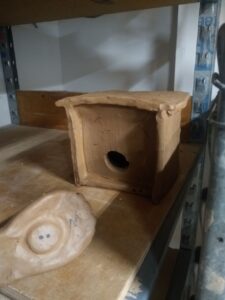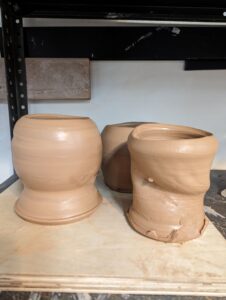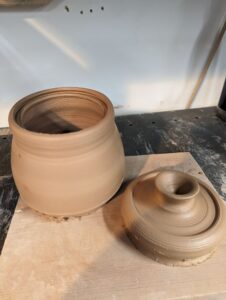An aspect of making and crafting I considered when invited to contribute to this special issue on physical data visualization is the possibility of confronting failure, especially the failure in the make, and the outcome possibly going very wrong. To be able to learn and grow as a crafter and data viz creator is to make many failed attempts before achieving some mastery. While the literature on “academic failure” focuses on the concept of student failure in learning1, little discusses the aspect of failure regarding program planning and implementing innovative teaching methods2. We read articles and postings of crafted data visualizations, and admire the beautifully knitted temperature scarf, or the carefully embroidered bar plots. What we rarely see are all the dropped stitches, the warped fabric, or the Play-Doh getting stuck in the carpet.
What I hope to be able to cover in my contribution is highlighting what happens when things don’t go according to plan, and how we can learn from that. Focusing on the outcomes from a workshop I led on crafting data visualization, I use my own experiences learning to make pottery, especially learning to measure my expectations about what I can create, to reflect on the process and the ways things can go wrong in teaching.
If there is anything guaranteed in ceramics, it is that you’ll leave behind a trail of failed makes before you make anything you’re happy with. Everything else is unpredictable, from the first attempt at centering your ball of clay on the wheel, to the final firing after glazing.
I picked up pottery in 2022 after my spouse and I completed a cross-country move for new jobs in a city I’ve never been to, in an attempt to be social and meet people outside of work, and to try the rare form of crafting that appealed to both of us (while I have a constant need to make things with my hands and developed a collection of cross-stitching, knitting, legos, and painting supplies, my spouse was never one to do arts & crafts until he joined me in binging “The Great Pottery Throwdown”3).
You’re told early on that being able to shape clay and make things on the wheel is magical, a result of the “body knowledge”, the muscle memory developed to instantly make cups, bowls, and pots with your hands4. As an amateur potter, you hope to go from haphazard clay mass to identifiable shapes in a few short lessons and tries on the wheel. Since my first time in the studio, I can only call myself mildly proficient in working with clay. Every part of making a piece is a waiting game in hoping that nothing breaks, and a small mistake early on can bring down all your efforts.

Image of a birdhouse made out of clay drying in an art studio. This was one of the only things I made in that first series of classes that survived at the end. It’s not structurally sound, nor can any bird live in it (good luck getting into that entry hole, birds!)
Before you can learn how to make on the wheel, you have to learn how to wedge and center your clay. Wedging uses your hands to mix the clay and ensures no air bubbles, much like kneading bread. Once wedged, you plop your ball of clay on the wheel head, smack it a couple of times to ensure it doesn’t fly off, and begin centering. The clay will want to fly out with the speed of the wheel, so centering keeps the clay in the center (you think this is obvious, but doing this is much harder than you think). Centering also makes sure that your walls are of equal thickness when you pull up. You need to use physical strength to center, and the more clay, the more force you need to apply. Without centering correctly, your pieces come out uneven, the clay will fly everywhere, and you might pull a muscle5.

2 pots made in the 3rd series of classes, drying in the studio after coming off the wheel. The piece on the right suffered a weak point and resulted in the twist.
Despite more than a year of learning in the studio, I still have a hard time centering. And yet, because I am stubborn, and because I’m in classes with others and begin to compare my skills to theirs, I power on in trying to make anything. My walls become uneven, I can’t pull tall walls, and my makes just collapse and break, but I thought that because I “understood” the concept of centering, it was enough. Sometimes this will work in my favor, but most times my pieces definitely do not look professional.
While I would be tempted to destroy the pieces that come out badly (and I do this to pieces that are beyond saving), I keep the ones with obvious errors. I find my makes precious since they have to go through a journey in the kiln, where they may break or explode. But I also tell myself each of the ways the pieces are deficient, and what I should have done instead. I tell myself that this will help me learn and grow in pottery. It’s a lesson I try to apply in my library work, especially when things aren’t going the way I hope.
In Spring 2023, I hosted a workshop on crafting data visualization for our digital scholarship group on campus. Physical makes of data visualization had been making the rounds on social media, and I had been inspired by Claudia Berger’s talk on Embodied Data6 to try something new. I also wanted to bring some levity and a possible new way to destress for our DS community, especially near the end of the school year. This wasn’t my first workshop; I had been leading library instruction sessions and workshops since 2020 and may have felt a little too secure in my abilities to pull off my plans. However, my plans for this workshop were a bit too ambitious for my skill level. The plan was for a hybrid, 2-hour long workshop, with the first hour focused on the history and cases of artistic crafted data visualizations, and the second hour used to learn basic crafting skills and how to make data viz. There were plans for a separate virtual crafting session for the attendees who couldn’t make it in person. The event was advertised for a few weeks, reaching beyond the digital scholarship community. I made sure to have yarn, needles, crochet hooks, Play-Doh, and any other materials I could think of to supply the crafting hour. I thought I was ready.

I made this jar a year into my pottery journey. Jars can be tricky, especially if you make a jar with a flange (the projecting collar under the lid that helps it stay on the body of the jar) and a gallery (the seat for the lid). I was very excited when I took the jar off the wheel. I cried a little when I squished the base during trimming.
On the day of the presentation, about 20 people joined in on Zoom, which was great! But, only 4 attendees, including our tech help who had to be there and a student who thought this was a traditional digital data visualization workshop, appeared for the in-person. Throughout the presentation, tech problems plagued the first hour, my mic kept on cutting out, and our Zoom attendees lost most of the first part of the presentation. The second hour wasn’t any better. I couldn’t get any of the participants to engage with the materials I brought. The overall feeling I had at the end of the workshop was of utter failure7.
This publication is about crafted data, but what can you craft when the data is close to zero? The answer would be nothing. If I wanted to make a stretch of an argument, I could make the argument that the crafted piece represents how the data makes me feel. Instead, I would rather focus on process, and how there’s commonality in the trial and error in working on things you spent so much time, resources, and energy on8.
When I think about the workshop, I think about how I let it go so wrong. But I also think about how when you’re making something, whether tangible or not, you can’t always expect perfection. You learn from the mistakes. You figure out whether the wheel was going too fast, whether the tension on your pulls was off, or whether your clay was too weak. And then you try again. Maybe I should have tried a different channel for advertising the workshop. Maybe I should have been clearer on what I wanted participants to do.
But you also don’t beat yourself up too much for how things turn out. You should be happy you made a thing! It’s not perfect, but you made it, and it’s yours. My workshop wasn’t perfect, but people showed up, and they heard me talk about something I think is pretty neat. We fail, and we learn, and we keep trying.

This is a teapot I made in my most recent series of pottery sessions. It’s not perfect, but I made it. Here’s hoping it survives the firing.
I’d like to thank Claudia Berger for both inspiring this attempt to teach physical data viz, as well as inviting me to contribute to this special issue. I’d also like to thank Pamella Lach who, along with Claudia, edited this piece and gave such thoughtful, supportive, and constructive feedback. This piece is better thanks to them.
References
Berger, Claudia. 2022. “‘Embodied Data Visualizations’ at DH Unbound 2022 https://claudiaeberger.com/embodied-data/embodied-data-visualizations-at-dh-unbound-2022/.
Carter, Ben, Linda Jane Arbuckle. 2016. Mastering the Potter’s Wheel: Technique, Tips, and Tricks for Potters. Minneapolis, MN: Voyageur Press.
Donte the Potter [pseud.]. “Centering for beginner [sic](common mistakes made),” posted April 4, 2019, YouTube video, 17:27, https://youtu.be/RXuUL_JzFs4?si=4sc554400tDh8HnW
Eckstein, Lydia E., Amelia B. Finaret, and Lisa B. Whitenack. 2023. “Teaching the Inevitable: Embracing a Pedagogy of Failure.” Teaching and Learning Inquiry 11 (May). https://doi.org/10.20343/teachlearninqu.11.16.
Gadsby, Florian. “How to Center Clay – A Beginner’s Guide,” posted March 27, 2022, YouTube video, 16:44, https://youtu.be/-YCGK33c0xs?si=uksIprn2wRtyqzKL
Holmes, Linda. “The Soothing ‘Great Pottery Throw Down’ Makes Great Isolation TV,” NPR, September 17, 2020, https://www.npr.org/2020/09/17/913564272/the-soothing-great-pottery-throw-down-makes-great-isolation-tv
Neff, Kristin D, Ya-Ping Hsieh, and Kullaya Dejitterat. 2005. “Self-Compassion, Achievement Goals, and Coping with Academic Failure.” Self & Identity 4 (3): 263–87. https://doi.org/10.1080/13576500444000317.
Norton, Christina, Anne Armstrong, Dee Anna Phares, Kristin Allen, Amy Hall, and Tish Hayes. 2023. “‘Survive and Sustain’: Adaptive and Innovative Library Instruction in the Time of COVID-19.” Internet Reference Services Quarterly 27 (2): 55–82. https://doi.org/10.1080/10875301.2022.2163021.
Proctor, Christopher L., Courtney M. Block, and Melanie E. Hughes. 2021. “Disaster Librarianship: Reflections on Teaching and Learning from the Heart of the Campus.” Journal of Teaching and Learning with Technology 10 (1). https://scholarworks.iu.edu/journals/index.php/jotlt/article/view/31289.
Vladis, Nathalie, Aspen Hopkins, and Arvind Satyanarayan. 2020. “Data Crafting: Exploring Data through Craft and Play.” In IEEE VIS Workshop on Data Vis Activities to Facilitate Learning, Reflecting, Discussing, and Designing. http://vis.csail.mit.edu/pubs/data-crafting/.
1. See Neff, Kristin D, Ya-Ping Hsieh, and Kullaya Dejitterat. 2005. “Self-Compassion, Achievement Goals, and Coping with Academic Failure.” Self & Identity 4 (3): 263–87. https://doi.org/10.1080/13576500444000317., Eckstein, Lydia E., Amelia B. Finaret, and Lisa B. Whitenack. 2023. “Teaching the Inevitable: Embracing a Pedagogy of Failure.” Teaching and Learning Inquiry 11 (May). https://doi.org/10.20343/teachlearninqu.11.16.
↩2. The exception being literature related to COVID-19. Example: Norton, Christina, Anne Armstrong, Dee Anna Phares, Kristin Allen, Amy Hall, and Tish Hayes. 2023. “‘Survive and Sustain’: Adaptive and Innovative Library Instruction in the Time of COVID-19.” Internet Reference Services Quarterly 27 (2): 55–82. https://doi.org/10.1080/10875301.2022.2163021., Proctor, Christopher L., Courtney M. Block, and Melanie E. Hughes. 2021. “Disaster Librarianship: Reflections on Teaching and Learning from the Heart of the Campus.” Journal of Teaching and Learning with Technology 10 (1). https://scholarworks.iu.edu/journals/index.php/jotlt/article/view/31289.
↩
3. “The Great Pottery Throwdown” is a British reality competition show that began in 2015 and has continued (with gaps around 2018-2020). Amatuer potters complete challenges every week that highlight various ceramic skills, with the goal of winning the title of “potter of the week” every episode and winning the overall series at the end. NPR’s pop culture critic Linda Holmes explains the appeal of the show in, “The Soothing ‘Great Pottery Throw Down’ Makes Great Isolation TV,” NPR, September 17, 2020, https://www.npr.org/2020/09/17/913564272/the-soothing-great-pottery-throw-down-makes-great-isolation-tv
↩
4. Ben Carter, Linda Jane Arbuckle, Mastering the Potter’s Wheel: Technique, Tips, and Tricks for Potters. ↩
5. If you’d like to see these steps in action, YouTube is very helpful. Earth Nation Ceramics (https://www.youtube.com/@EarthNationCeramics) and Florian Gadsby (https://www.youtube.com/@floriangadsby) are two channels I think are good at explaining the processes. Specifically, Gadsby’s “How to Center Clay – A Beginner’s Guide” (uploaded March 27, 2022 https://youtu.be/-YCGK33c0xs?si=f2xE13FmuGgyICh-) and ENC’s “Centering for beginner [sic](common mistakes made)” (uploaded April 4, 2019 https://youtu.be/RXuUL_JzFs4?si=4sc554400tDh8HnW).
↩
6. “‘Embodied Data Visualizations’ at DH Unbound 2022 – Claudia Berger.” 2022. May 31, 2022. https://claudiaeberger.com/embodied-data/embodied-data-visualizations-at-dh-unbound-2022/. ↩
7. If you’d like to learn about a workshop that was successful, see Vladis, Nathalie, Aspen Hopkins, and Arvind Satyanarayan. 2020. “Data Crafting: Exploring Data through Craft and Play.” In IEEE VIS Workshop on Data Vis Activities to Facilitate Learning, Reflecting, Discussing, and Designing. http://vis.csail.mit.edu/pubs/data-crafting/.
↩
8. There’s another discussion worth having here about the similarities of the steep learning curves of certain crafts and tools used to make data viz, especially noting how intimidating they both can be. ↩
Natalia Estrada (she/they) is the Digital Scholarship Librarian at the University at Buffalo (SUNY). She grew up in Los Angeles, and lived in Chicago and Berkeley before ending up in Western New York. She has worked in academic libraries for almost 20 years, and has focused their work on library hiring and promotion issues. Her pottery has been described as "fine" and "interesting" by friends and instructors.